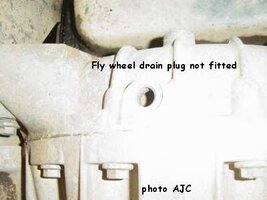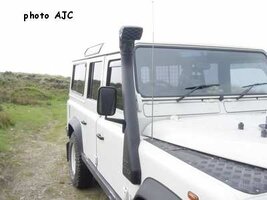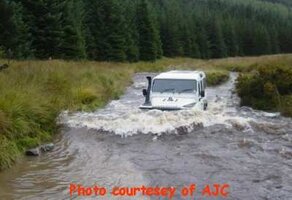Okay, the last article covered the very basics. This time, let’s go into a little more depth, this time dealing with some of the wetter conditions you may encounter.
Driving on soft ground.
You may find that reduced tyre pressures will aid with traction when driving on soft ground. Less pressure gives a bigger ‘footprint’, though has the added disadvantage of lowering the ground clearance…something which must be considered if the soft ground you intend to cover has deep ruts.
Once you return to firmer ground you must re-inflate the tyres to the correct pressures.
Crossing a ditch
Ideally, you should always cross a ditch at an angle. This way, at least three wheels are in contact with the ground on either side of the ditch and therefore help push (or pull) the fourth wheel through the ditch. If you were to approach the ditch at right angles, then in all probability you would have the front wheels drop in to the ditch, and you would be stuck with the chassis trapped on one side, and the bumper stuck on the opposite side!
Wading.
Land Rover state that the maximum ‘advisable’ depth for fording and wading is around 0.5 metres.
Before attempting a water crossing, try and ascertain the depth of the water, and if there are any hidden pitfalls, such as pits or large rocks. Stagnant or still water is more likely to cause problems, as unlike a flowing river or stream there can be a build up of silt and mud which can be several feet deep in places. With this in mind, you must always make sure that the bed of the river, stream or pool will support the weight of your vehicle.
Make sure you have the wading plug fitted to the clutch housing drain hole, and the timing belt housing where appropriate.


If the depth of water should exceed the 0.5 metres, then further precautions will be necessary;
Remove the fan belt, as this will stop the cooling fan spraying water all over the engine bay, ignition and air cleaner. Replace the fan belt as soon as you finish wading.
Obviously, it may not be possible to remove the fan belt in some circumstances, in which case a sheet of plastic draped over the radiator grille can prevent a lot of water passing through the radiator, and help reduce the amount of water that gets sprayed around the engine bay.

Ensure the engine air intake is kept well clear of the water, either by making sure you know the depth of the water, or by fitting a snorkel.
Use a low gear, and keep the throttle steady, and revving enough to avoid stalling the engine if the exhaust is below water.
Drive slowly and steadily to create a ‘bow wave’ in front of the vehicle… The ‘bow wave’ will create a vortex behind it, which also helps keep water out of the engine bay. (you should be able to see this in the photo below)

After wading
Refit the fan belt if you removed it.
Remove the clutch housing wading plug and timing cover wading plug where fitted.
Remove any plastic sheeting you may have placed over the grille, and check that there is no leaf debris or mud within the radiator core. If there is any, this should be removed immediately to prevent overheating.
Make sure that the brakes are dried out as soon as possible after exiting the water, to ensure they are working when needed. You can do this by driving for a short distance with the brakes lightly applied…the resultant friction heats the brakes up and dries them off.
Finally
If you intend to do a lot of wading, it is a very good idea to check your vehicles transmission oils after each trip for water contamination. It is easily recognised by its milky mayonnaise like appearance. Change the oils if this happens!
Click for part 1 | Click for part 3
Driving on soft ground.
You may find that reduced tyre pressures will aid with traction when driving on soft ground. Less pressure gives a bigger ‘footprint’, though has the added disadvantage of lowering the ground clearance…something which must be considered if the soft ground you intend to cover has deep ruts.
Once you return to firmer ground you must re-inflate the tyres to the correct pressures.
Crossing a ditch
Ideally, you should always cross a ditch at an angle. This way, at least three wheels are in contact with the ground on either side of the ditch and therefore help push (or pull) the fourth wheel through the ditch. If you were to approach the ditch at right angles, then in all probability you would have the front wheels drop in to the ditch, and you would be stuck with the chassis trapped on one side, and the bumper stuck on the opposite side!
Wading.
Land Rover state that the maximum ‘advisable’ depth for fording and wading is around 0.5 metres.
Before attempting a water crossing, try and ascertain the depth of the water, and if there are any hidden pitfalls, such as pits or large rocks. Stagnant or still water is more likely to cause problems, as unlike a flowing river or stream there can be a build up of silt and mud which can be several feet deep in places. With this in mind, you must always make sure that the bed of the river, stream or pool will support the weight of your vehicle.
Make sure you have the wading plug fitted to the clutch housing drain hole, and the timing belt housing where appropriate.


If the depth of water should exceed the 0.5 metres, then further precautions will be necessary;
Remove the fan belt, as this will stop the cooling fan spraying water all over the engine bay, ignition and air cleaner. Replace the fan belt as soon as you finish wading.
Obviously, it may not be possible to remove the fan belt in some circumstances, in which case a sheet of plastic draped over the radiator grille can prevent a lot of water passing through the radiator, and help reduce the amount of water that gets sprayed around the engine bay.

Ensure the engine air intake is kept well clear of the water, either by making sure you know the depth of the water, or by fitting a snorkel.
Use a low gear, and keep the throttle steady, and revving enough to avoid stalling the engine if the exhaust is below water.
Drive slowly and steadily to create a ‘bow wave’ in front of the vehicle… The ‘bow wave’ will create a vortex behind it, which also helps keep water out of the engine bay. (you should be able to see this in the photo below)

After wading
Refit the fan belt if you removed it.
Remove the clutch housing wading plug and timing cover wading plug where fitted.
Remove any plastic sheeting you may have placed over the grille, and check that there is no leaf debris or mud within the radiator core. If there is any, this should be removed immediately to prevent overheating.
Make sure that the brakes are dried out as soon as possible after exiting the water, to ensure they are working when needed. You can do this by driving for a short distance with the brakes lightly applied…the resultant friction heats the brakes up and dries them off.
Finally
If you intend to do a lot of wading, it is a very good idea to check your vehicles transmission oils after each trip for water contamination. It is easily recognised by its milky mayonnaise like appearance. Change the oils if this happens!
Click for part 1 | Click for part 3
